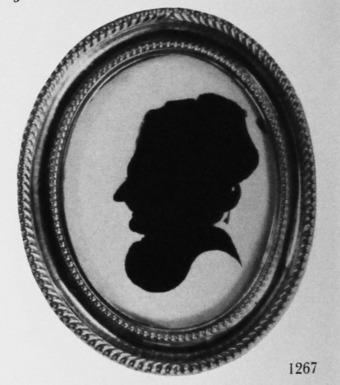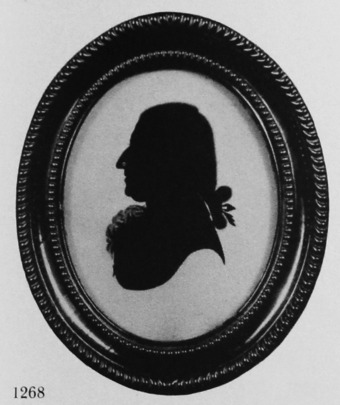Lightfoot, Mary, Miss (McKechnie Section 4)
Not previously recorded; any silhouettes signed or labelled 'M. Lightfoot' have hitherto been ascribed to her mother, Mrs Mary Lightfoot (q.v.). The identity of the younger Mary Lightfoot, however, is established by a reference in an advertisement in the Caledonian Mercury (18 October 1786), issued in Edinburgh by John Miers, who had earlier lodged at the house of her mother in Castle Street, Liverpool, from June 1785 until January 1786. Miers had arrived in Edinburgh only to find that Miss Lightfoot had preceded him thither and had published the following advertisement in the Caledonian Mercury
(18 September 1786):
Most Striking Likenesses in Miniature Profile, on a peculiar plan, allowed by everyone to be Superior to any others in the Kingdom, taken by M. Lightfoot, who will be here in a few weeks from Glasgow.
These Likenesses are printed upon a composition perfectly white, and executed with the most invariable correctness, whereby the exact symetry, and animated expression of the features are preserved, and finished with such peculiar softness and elegance, as have excited the admiration of every observer. The whole process is exceedingly short, not more than one minute for the time of sitting. M. Lightfoot engages every profile to be a perfect likeness, and requires no gratuity, unless her performance meet the entire approbation of those who employ her, as she wishes to rest her success on her merit.
The profiles will be delivered in frames elegantly gilt, from 4s. to 7s. 6d. each, or reduced on ivory, at 10s.
Specimens of her performance may be seen at Mr. Creech's High Street, Edinburgh.
In the course of his own advertisement, published a month later, Miers claims to have invented the method of the 'reduction of profile likenesses'. He then mentions his stay in Liverpool at the house of Mrs Lightfoot, `whose daughter', he continues,
at that time is well known to have had no idea of taking Likenesses in any way whatever. From the little she had meanly and clandestinely picked up of his art, however, she set off for Glasgow, and advertised herself in the very words Mr. Miers had used at Liverpool, and exhibited several of his Profiles as her own, which, when expostulated with on the impropriety of such conduct, she acknowledged to be his.
With these facts, which he defies her to contradict, he appeals not only to the justice of a generous public, but also their discernment, and only begs they will compare her real performances with his. On his exhibiting some profiles in Mr. Creech's shop along with M. Lightfoot's, she withdrew hers; he has, therefore, sent some to Mess. Forrester and Company, Mr. Elliot's, bookseller, Parliament Square, and Mr. Smith's, perfumer, her new places of exhibition, and to Prince's Street Coffee house.
The full text of this advertisement is quoted in the entry on Miers in this Section. Miers had visited Leeds and Manchester after leaving Liverpool arid before arriving in Edinburgh. It appears ' that Miss Lightfoot, having pirated his ideas and copied his methods after his spell of work in Liverpool, had taken advantage of his delayed arrival in Edinburgh by attempting to compete with him first in Glasgow and then in Edinburgh. It is likely that Mrs Lightfoot also made a similar attempt to profit from her association with Miers. In the light of Miers's advertisement, it is clear that the daughter was not Miers's pupil. Likewise, it is clear that it was Miss, not Mrs, Lightfoot who issued the advertisement in the Caledonian Mercury of 18 September 1786.
Since most of what little we have of Miss Lightfoot's work was painted in Glasgow, it seems probable that Miers's advertisement achieved the effect of putting her out of business in Edinburgh. The available evidence suggests that she soon left Edinburgh and abandoned silhouette work. She was certainly back in Liverpool by 1790; street directories give the following addresses for her, but list no occupation: 1790, 34 Water Street; 1796-1803, 12 Water Street; 1805-07, 11 Newington. In later entries she is listed, at various addresses, as a 'victualler'.
As can be assumed, Miss Lightfoot worked much in the style of John Miers during his 'travelling period'. By 1786, Miers had achieved a softer finish for his costume detail; in her formation of ribbons, Miss Lightfoot closely follows Miers's 'arrow-and- plume' pattern. The cap with lappets on one illustrated example bears interesting comparison with the detail by Miers on the frills shown on the profiles of the Foxcroft and Doran families known to have been taken by him in Liverpool.
1269
Note should be taken of the especially sharp point at the back of the bust-line termination on the few extant examples of Miss Lightfoot's work. his because of this singular feature that I have ascribed the profile of Mrs Foxcroft to Miss Lightfoot. This profile would have been taken in Liverpool between January and late summer 1786, while Miers was in Leeds.
Miss Lightfoot's trade label (illustrated) bears a similarity in wording to her advertisement in the Caledonian Mercury. It reads as follows:
PERFECT LIKENESSES
MINIATURE PROFILE
Taken by
M. LIGHTFOOT, LIVERPOOL
And reduced on a plan entirely new, which preserves most exact symmetry and animated expression of the features, much superior to any other me[thod]
— Time of sitting one minute.
NB. She keeps the original shades, and can supply those she has once taken with any number of duplicates. Those who have shades by them may have them reduced, and dressed in the present taste.
Ills. 1267-1270

Mrs Foxcroft the elder
Silhouette painted on thin plaster
1786
3 ½ x 2 ¾ in./90 x 70mm.
Frame: oval, hammered brass
Attributed to Miss Lightfoot on account of its shape. Some of the sitter’s relatives and descendants were painted by Mrs Mary Lightfoot and by John Miers.
By courtesy of R. F. Robertson-Glasgow

Unknown man
Silhouette painted on plaster
1786
3 ½ x 2 ¾ in./90 x 70mm.
Frame: oval, hammered brass
Painted in Glasgow. The treatment of the shirt-frill is similar to the same feature of the silhouettes painted by Miers in Liverpool earlier in 1786.
T. R. Bruen collection

Unknown woman
Silhouette painted on plaster
1786
3 ½ x 2 ¾ in./90 x 70mm.
Frame: oval, hammered brass
Possibly one of the silhouettes exhibited by Miss Lightfoot in Mr Creech’s shop, Edinburgh. The frame is of a size which Miers favoured at that period.
J. A. Pollak collection

Trade label of Miss Mary Lightfoot, from the reverse of the silhouette illustrated in 1269.
J. A. Pollak collection
